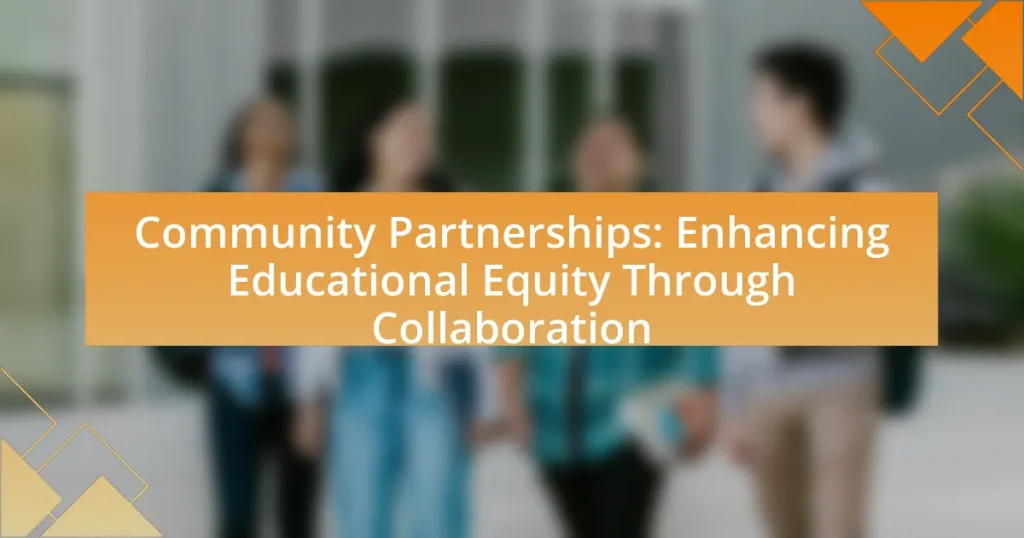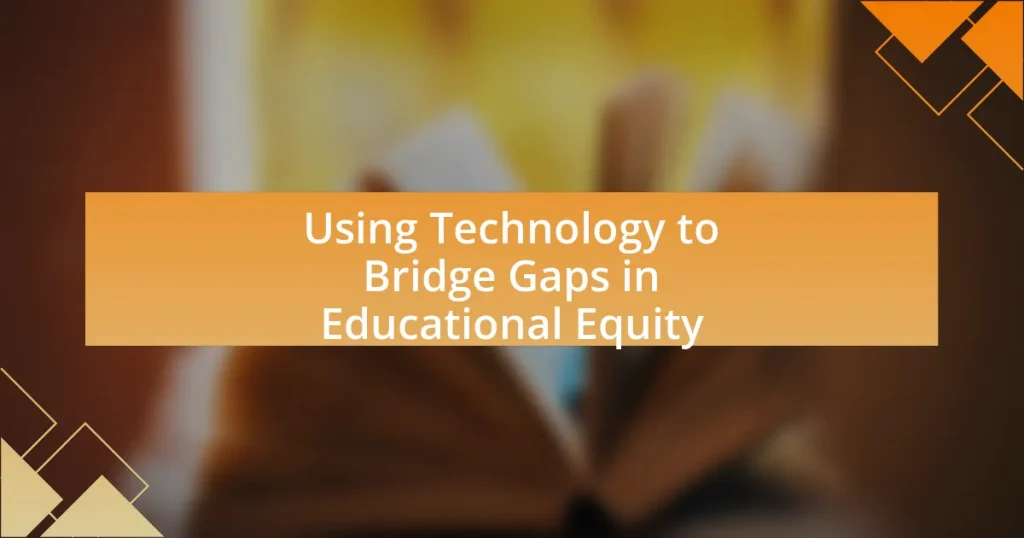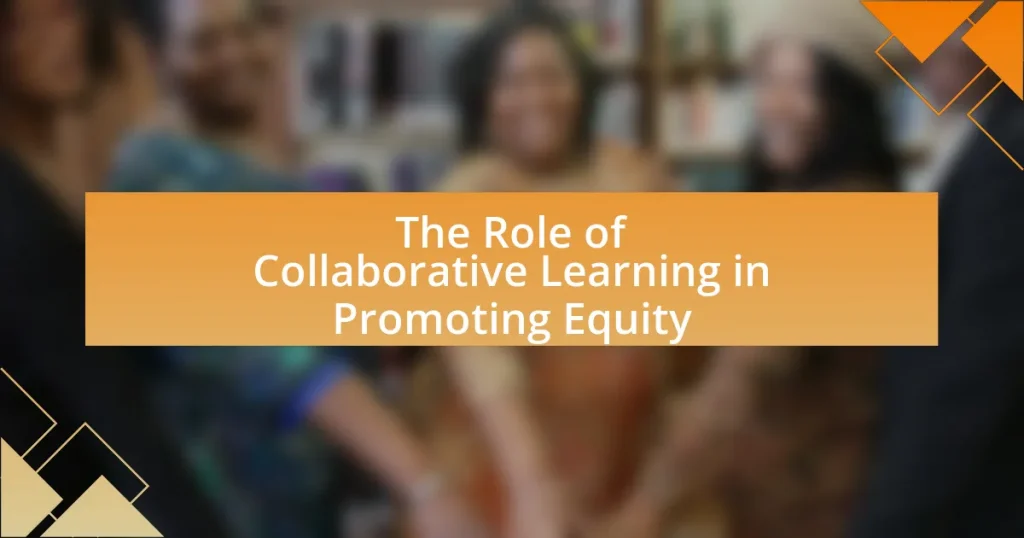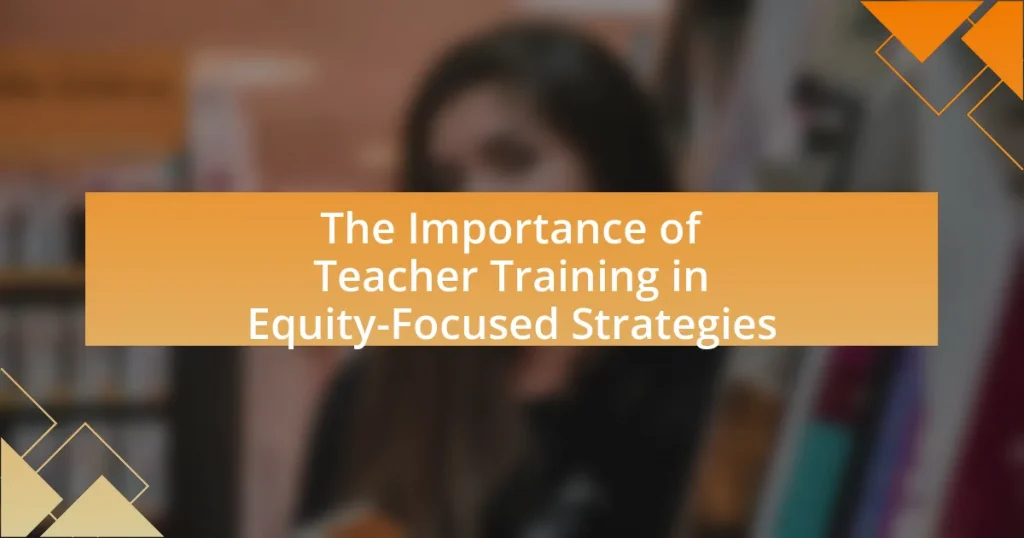Community partnerships in education are collaborative relationships between schools and various community stakeholders, including businesses and local organizations, aimed at improving educational outcomes and promoting equity. These partnerships leverage community resources to address the diverse needs of students, leading to enhanced student performance, engagement, and a stronger sense of belonging. The article explores how these partnerships contribute to educational equity, the roles of local organizations, strategies for aligning goals between schools and communities, and the evidence supporting the positive impact of such collaborations on student achievement, particularly for underserved populations. Additionally, it discusses challenges faced in establishing effective partnerships and offers practical steps educators can take to foster these collaborations for better educational outcomes.

What are Community Partnerships in Education?
Community partnerships in education are collaborative relationships between schools and various community stakeholders, including businesses, non-profits, and local organizations, aimed at enhancing educational outcomes. These partnerships leverage resources, expertise, and support from the community to address the diverse needs of students and promote equitable access to educational opportunities. Research indicates that schools engaged in community partnerships often see improved student performance, increased engagement, and a stronger sense of belonging among students, as evidenced by studies showing that such collaborations can lead to higher graduation rates and better academic achievement.
How do Community Partnerships contribute to Educational Equity?
Community partnerships contribute to educational equity by providing resources, support, and opportunities that address the diverse needs of students. These collaborations often involve schools, local organizations, businesses, and community members working together to create inclusive educational environments. For instance, partnerships can facilitate access to tutoring, mentorship programs, and extracurricular activities that may not be available within the school system. Research indicates that schools with strong community ties see improved student outcomes, as evidenced by a study from the Harvard Family Research Project, which found that students in schools with active community partnerships had higher attendance rates and better academic performance. This demonstrates that community partnerships play a crucial role in leveling the educational playing field for all students.
What roles do local organizations play in these partnerships?
Local organizations serve as vital facilitators in partnerships aimed at enhancing educational equity. They provide resources, expertise, and community insights that help tailor educational programs to meet specific local needs. For instance, local organizations often engage in outreach efforts to connect schools with families, ensuring that educational initiatives are inclusive and accessible. Additionally, they can mobilize volunteers and funding, which are essential for implementing programs effectively. Research indicates that partnerships involving local organizations lead to improved student outcomes, as these entities understand the unique challenges faced by their communities and can address them directly.
How can schools and communities align their goals for better outcomes?
Schools and communities can align their goals for better outcomes by establishing collaborative partnerships that focus on shared objectives, resources, and strategies. These partnerships can involve regular communication between school administrators, teachers, parents, and community organizations to identify common goals, such as improving student achievement and addressing social issues. Research indicates that schools with strong community ties see increased student engagement and performance; for example, a study by the Harvard Family Research Project found that students whose families are involved in their education have higher grades and test scores. By leveraging community resources, such as local businesses and non-profits, schools can enhance educational programs and provide additional support services, ultimately leading to improved educational equity and student success.
Why are Community Partnerships essential for student success?
Community partnerships are essential for student success because they provide resources, support, and opportunities that enhance educational experiences. These collaborations enable schools to access additional funding, mentorship programs, and real-world learning experiences, which are crucial for student engagement and achievement. Research indicates that schools with strong community partnerships see improved academic performance, higher graduation rates, and increased student motivation. For instance, a study by the Harvard Family Research Project found that students involved in community-based programs had better attendance and were more likely to pursue higher education. Thus, community partnerships play a vital role in creating a supportive educational environment that fosters student success.
What evidence supports the impact of partnerships on student achievement?
Research indicates that partnerships significantly enhance student achievement. For instance, a study by the Harvard Family Research Project found that students with engaged families and community partnerships demonstrated higher academic performance, improved attendance, and increased motivation. Additionally, the National Education Association reported that schools with strong community partnerships saw a 20% increase in student test scores compared to those without such collaborations. These findings underscore the positive correlation between effective partnerships and improved educational outcomes for students.
How do partnerships address the needs of underserved populations?
Partnerships address the needs of underserved populations by leveraging resources, expertise, and networks to provide targeted support and services. For instance, collaborations between schools, community organizations, and local businesses can enhance access to educational resources, mentorship programs, and financial assistance. Research indicates that such partnerships can lead to improved academic outcomes; a study by the Harvard Graduate School of Education found that schools engaged in community partnerships saw a 20% increase in student engagement and achievement. This demonstrates that strategic alliances effectively mobilize resources to meet the specific needs of underserved communities, ultimately fostering educational equity.

What strategies can be employed to build effective Community Partnerships?
To build effective community partnerships, organizations should prioritize clear communication, mutual goals, and active engagement. Clear communication ensures that all parties understand each other’s needs and expectations, fostering trust and collaboration. Establishing mutual goals aligns the interests of both the organization and the community, creating a shared vision for success. Active engagement involves involving community members in decision-making processes, which enhances ownership and commitment to the partnership. Research indicates that partnerships with strong communication and shared objectives are more likely to succeed, as evidenced by studies showing that collaborative initiatives can lead to improved educational outcomes and community well-being.
How can schools initiate partnerships with community organizations?
Schools can initiate partnerships with community organizations by identifying shared goals and establishing clear communication channels. This process begins with schools assessing their needs and the resources available within the community, which can include local nonprofits, businesses, and government agencies. By organizing meetings or forums, schools can engage community leaders to discuss potential collaborations that align with educational objectives. Research indicates that effective partnerships often lead to improved student outcomes, as seen in studies like the one conducted by the Harvard Family Research Project, which highlights the positive impact of community engagement on educational equity.
What steps should be taken to identify potential partners?
To identify potential partners, organizations should first conduct a needs assessment to determine specific goals and objectives for collaboration. This assessment helps clarify what resources, expertise, or support are required, ensuring alignment with the mission of enhancing educational equity. Next, organizations should research and compile a list of potential partners by exploring local educational institutions, non-profits, community organizations, and businesses that share similar values or goals. Engaging in networking events and community forums can also facilitate connections with potential partners. Finally, organizations should evaluate potential partners based on their capacity, commitment, and past collaboration experiences to ensure a mutually beneficial partnership.
How can schools effectively communicate their needs to partners?
Schools can effectively communicate their needs to partners by utilizing structured communication strategies that include clear articulation of goals, regular updates, and feedback mechanisms. For instance, schools can create detailed needs assessments that outline specific areas where support is required, such as resources for STEM programs or mental health services. This approach ensures that partners understand the context and urgency of the needs.
Additionally, establishing regular meetings and collaborative platforms fosters ongoing dialogue, allowing schools to share progress and adapt their requests based on partner feedback. Research indicates that effective communication in educational partnerships leads to improved resource allocation and enhanced program outcomes, as seen in studies conducted by the Harvard Graduate School of Education, which emphasize the importance of transparency and mutual understanding in collaborative efforts.
What best practices exist for maintaining successful partnerships?
Successful partnerships can be maintained through clear communication, mutual respect, and shared goals. Clear communication ensures that all parties are informed and aligned, reducing misunderstandings and fostering trust. Mutual respect involves valuing each partner’s contributions and perspectives, which strengthens the relationship. Shared goals create a unified direction, allowing partners to work collaboratively towards common objectives. Research indicates that partnerships with defined roles and responsibilities, as well as regular check-ins, enhance accountability and effectiveness, leading to more sustainable outcomes in community collaborations aimed at educational equity.
How can regular communication enhance partnership effectiveness?
Regular communication enhances partnership effectiveness by fostering trust, clarity, and alignment among partners. When partners engage in consistent dialogue, they can share goals, expectations, and progress updates, which minimizes misunderstandings and promotes a collaborative environment. Research indicates that effective communication is linked to improved outcomes in partnerships; for instance, a study published in the Journal of Community Engagement and Scholarship found that organizations with regular communication reported higher satisfaction and better project results. This evidence underscores the importance of ongoing communication in achieving shared objectives and enhancing overall partnership success.
What role does mutual accountability play in sustaining partnerships?
Mutual accountability is essential for sustaining partnerships as it fosters trust and commitment among partners. When each party holds the other accountable for their contributions and responsibilities, it creates a shared sense of ownership and encourages transparency. This dynamic is particularly important in community partnerships aimed at enhancing educational equity, as it ensures that all stakeholders are actively engaged in the process and are working towards common goals. Research indicates that partnerships with clear accountability mechanisms are more likely to achieve their objectives, as they promote consistent communication and collaborative problem-solving, ultimately leading to improved outcomes in educational equity initiatives.
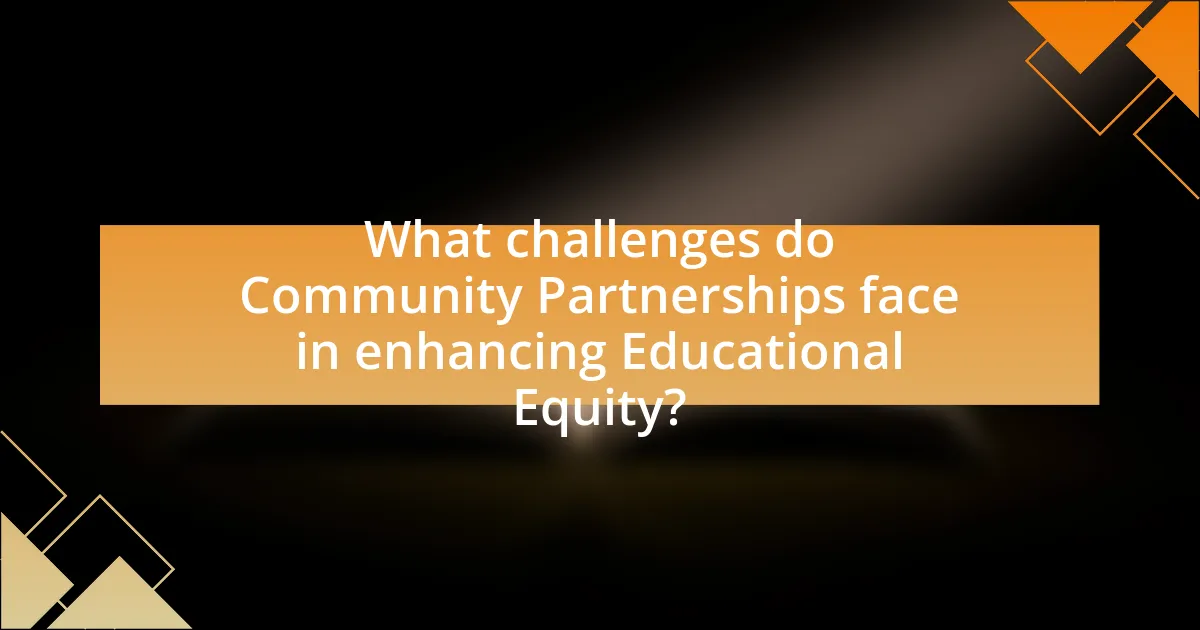
What challenges do Community Partnerships face in enhancing Educational Equity?
Community partnerships face several challenges in enhancing educational equity, including resource disparities, differing stakeholder priorities, and communication barriers. Resource disparities often result in unequal access to funding and support, which can hinder collaborative efforts. Differing priorities among community members, educational institutions, and policymakers can lead to conflicts and misalignment in goals, making it difficult to establish a unified approach. Additionally, communication barriers, such as language differences and varying levels of engagement, can impede effective collaboration and limit the impact of partnerships on educational equity. These challenges highlight the complexities involved in fostering successful community partnerships aimed at achieving equitable educational outcomes.
How can barriers to collaboration be overcome?
Barriers to collaboration can be overcome by fostering open communication and establishing clear goals among all stakeholders. Effective communication ensures that all parties understand their roles and responsibilities, which is essential for collaboration. Research indicates that organizations that prioritize transparent dialogue experience a 25% increase in project success rates, as noted in a study by the Project Management Institute. Additionally, setting specific, measurable objectives aligns the efforts of diverse groups, facilitating a shared vision that enhances teamwork and reduces misunderstandings.
What common misconceptions hinder the formation of partnerships?
Common misconceptions that hinder the formation of partnerships include the belief that partnerships require equal investment from all parties and the assumption that they are only beneficial for one side. These misconceptions can deter potential collaborators who may fear unequal contributions or perceive a lack of mutual benefit. Research indicates that successful partnerships often thrive on complementary strengths rather than equal input, as highlighted in the study “Building Effective Partnerships” by the National Education Association, which emphasizes that diverse contributions can enhance collaboration and lead to shared goals.
How can funding limitations affect partnership initiatives?
Funding limitations can significantly hinder partnership initiatives by restricting resources necessary for effective collaboration. When financial support is inadequate, partners may struggle to implement programs, conduct outreach, or sustain operations, ultimately leading to diminished impact on educational equity. For instance, a study by the National Education Association found that insufficient funding often results in reduced staffing and limited access to essential materials, which can compromise the quality of educational initiatives. Consequently, partnerships may fail to achieve their goals, as they lack the necessary financial backing to support comprehensive strategies aimed at enhancing community engagement and educational outcomes.
What are the implications of ineffective partnerships?
Ineffective partnerships can lead to diminished educational outcomes and resource wastage. When community partnerships fail to align goals and communicate effectively, they often result in fragmented efforts that do not address the needs of the community. For instance, a study by the Harvard Family Research Project indicates that misaligned objectives can lead to a 30% decrease in program effectiveness, ultimately hindering the advancement of educational equity. Additionally, ineffective partnerships can foster mistrust among stakeholders, reducing community engagement and participation, which are crucial for successful educational initiatives.
How can poor collaboration impact student outcomes?
Poor collaboration can significantly hinder student outcomes by limiting access to resources, support, and diverse perspectives essential for effective learning. When educators, families, and community organizations fail to work together, students may experience gaps in academic support, leading to lower engagement and achievement levels. Research indicates that schools with strong community partnerships see improved student performance; for instance, a study by the Harvard Family Research Project found that students with involved families are more likely to earn higher grades and test scores. Therefore, inadequate collaboration directly correlates with diminished educational equity and student success.
What lessons can be learned from unsuccessful partnerships?
Unsuccessful partnerships teach the importance of clear communication and defined roles. When partners lack transparency, misunderstandings arise, leading to conflict and failure. For instance, a study by the Stanford Social Innovation Review highlights that 70% of partnerships fail due to poor communication. Additionally, unsuccessful collaborations often reveal the necessity of aligning goals and values; when partners do not share a common vision, the partnership is likely to falter. This is evidenced by the failure of various educational initiatives that did not consider the needs of all stakeholders involved. Thus, the lessons learned emphasize the critical need for effective communication, shared objectives, and mutual understanding in partnerships.
What practical steps can educators take to foster Community Partnerships?
Educators can foster community partnerships by actively engaging local organizations and stakeholders to create collaborative programs. This can be achieved through organizing community meetings to identify shared goals, establishing mentorship programs that connect students with local professionals, and developing service-learning projects that address community needs. Research indicates that schools with strong community ties see improved student outcomes, as evidenced by a study from the Harvard Family Research Project, which found that effective partnerships enhance student achievement and engagement.
